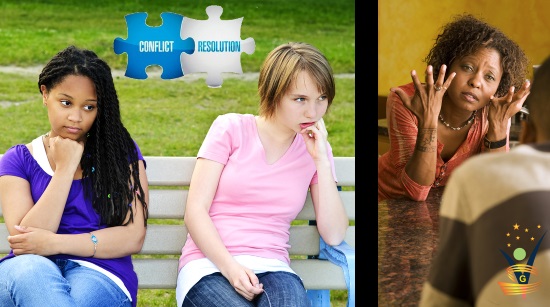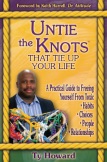Resolving Conflict Between Teens
or a Teen and an Adult

Copyright © 2010 by Ty Howard. All rights reserved.
The teen years are filled with growth, promise, trials, and tribulations. During this trying period, teens receive mixed messages from the many voices and experiences in every facet of their lives: family life, academics, sports, music, social situation, media, Internet, friends, classmates, money matters, work, abuse, dating drama, addiction, depression, and peer pressure. Through this relentless whirlwind of voices and experiences, a teen will at one point or another find him/her self caught up in a conflict with another teen, their parent(s), a family member, an educator, adult or employer.
Conflict is a fact of life. While conflict, tension, and misunderstandings are a normal and inevitable part of a growing teen’s life, if left unresolved they result in toxic stress, anger issues, poor choices, and disciplinary consequences for the teen who is never taught or guided through an effective process on how to resolve conflict amicably.
The good news? It doesn’t have to be and stay this way. Armed with practical step-by-step strategies and the desire to resolve conflict with or between a teen and someone else, you can – over time — teach, guide and coach a teen effectively on how to resolve conflict peacefully, safely, non-violently, and successfully.
Here is a practical step-by-step process for working effectively through conflict in the workplace:
Step 1: Calm down / Cool off period.
Whenever there is a conflict between a teen and someone else, separate and allow the participants involved to take a “Calm down / Cool off period.” The tension level of the conflict should be the barometer to help you to determine how long this period should be.
When emotions and minds become calm and clear, the process of conflict resolution becomes easier to steer (navigate).
Step 2: Set the stage.
Bring the participants involved in the conflict to an empty meeting room where you can close the door and block out all possible distractions if the room has windows. Share with them the clear ground rules for the meeting. Make sure your ground rules have a clear and sound method on how communication will go and flow throughout the meeting. Also, let the participants know that your goal as the leader of the meeting is to get everything out in the open in a controlled and respectful manner, and to ultimately resolve the conflict moving forward.
Be mindful that as the leader of the meeting, you must lead by example while communicating and orchestrating the meeting in a professional, respectful and non-aggressive (attacking or argumentative) manner.
A conflict resolution stage well set leads to the successful meeting ground rules being met.
Step 3: Tell what’s bothering you using “I messages.”
When participants share what’s bothering them using “I messages” or “I statements,” it unearths and creates the lines of open and honest communication. “I messages” evoke true emotions and feelings behind what’s being said.
An “I message” filled dialogue breaks people through the tension clog of conflict.
Step 4: Each person restates what they heard the other person say.
After each person involved in the conflict shares their “I messages,” have the other person(s) restate what they heard that person say. This step creates an opportunity for everyone to gain clarity and understanding of how the tension and conflict came about.
Restating what you heard allows the other person to bring clarity to their words, so no one is left to assume the other person’s behavior or intentions.
Step 5: Define the problem and take responsibility.
Once everything has been openly and honestly communicated in a controlled and respectful manner, it’s now time for all involved to define the problem and take responsibility for their participation in the conflict.
When people define and take responsibility of their part in a conflict situation, they release healthy human intentions to resolve the situation.
Step 6: Brainstorm and evaluate solution options.
The most effective way to end a conflict with a teen or between the participants involved is to empower them to brainstorm and evaluate the solution options that will enable them to resolve their conflict.
People rarely reject solution options they brainstorm and evaluate to resolve their conflict problems.
Step 7: Negotiate down to one solution option, and create an agreement.
It’s great when teens (people) involved in a conflict come up with several possible solution options to resolve their conflict. This at least allows those involved to create an Option A, B, or C. In order to make this happen, the conflict participants have to negotiate down to one solution option, and create an agreement to execute the practicing of this one solution option immediately.
People rarely quit on the solution option they negotiate down to and agree on when working to resolve their conflict situation.
Step 8: Affirm, Forgive, or Thank.
Do not expect feelings, emotions and negative attitudes between teens or people involved in a conflict with a teen to change immediately after one successful meeting. Depending on the situation at hand, resolving the conflict can often be a time-consuming and laborious process. If and when you make it to this step in working to resolve a conflict between teens or a teen and an adult, simply look at it as progress, small victories won.
If you can get the conflict participants to “Affirm” that they will honestly work to uphold their newly instated agreement, that’s a small victory won. If you can get the conflict participants to genuinely “Forgive” one another without you forcing them to do so, that’s a small victory won. If you can get the conflict participants to “Thank” one another for listening caringly to what they had to say and to agreeing to work to resolve and move forward from the conflict, that’s a small victory won. Affirm, Forgive, or Thank are small victories to win and celebrate when it comes to resolving conflict at work.
Successful conflict resolution is always the result of small victories won, over time.
Step 9: Put the agreed upon option into practice.
What good is it to have a negotiated and agreed upon solution option for a current conflict going on between teens or a teen and an adult, if you do not put it into practice? Just as strategic planning and execution of a new plan (goals and objectives moving forward) is highly important for the success of an entire organization, so rings true for the strategic planning and execution of a new plan (goals and objectives moving forward) to resolve conflict between teens or a teen and an adult. Do not leave the agreement to resolve a conflict between the participants (between teens or a teen an adult) involved to mere words in the air and a shake of hands. Type up a short one page agreement of the participants’ agreement, and have everyone present at the meeting to sign and date it. Your agreement should state clearly and briefly what everyone has agreed to and acknowledge that the practicing and follow-through of the solution option is now officially in place.
When resolving a conflict between teens or a teen and an adult, you must put into practice along with the initial agreement, a typed, signed and dated action plan. The action plan will act as a recall and coaching tool for everyone involved in the conflict resolution part of the situation.
Step 10: Schedule an impromptu follow-up.
Inform the participants (the teens or the teen and adult) involved in the conflict that there will be an impromptu follow-up to their successful meeting and signed agreement. When it comes to conflict resolution, I prefer an impromptu meeting over an announced and pre-scheduled meeting. When participants know there is a pre-scheduled meeting, they often shape up and fly straight long enough to make it to and through the announced pre-scheduled meeting. Just let the participants know that there will be an impromptu follow-up meeting to take place within the next 90 days. In the meantime, you determine when and how you will call the participants back to and into your follow-up meeting.
If you wish to see and evaluate the true impact of your conflict resolution coaching skills and this process, always schedule an impromptu follow-up meeting so the real and true participants show up for the conflict follow-up session. This method will allow you to effectively gage if the conflict is completely over, or if you still have more conflict coaching to do until the situation is completely resolved. Initially, this entire process may be extremely time-consuming and frustrating for everyone involved, yet, it needs to be done. If it gets too frustrating or you do not feel like you’re making progress, don’t quit on the process. No matter how big or small your conflict may be—you can do something positive and progressive to eventually break your conflict participants free. Stay the course!
Communicate to your to all participants involved in the conflict that not all conflict is “bad,” it can be a driving force for teaching, learning, understanding, and the updating of solutions that may have worked in the past. That’s constructive conflict and should be within everyone’s skill set to navigate. If the conflict started in a school setting, family setting, work setting, team setting or youth organization setting, as the leader of the meeting, go back to ask all non-participants for their positive support and refusal to participate in any way that will make the current conflict situation worse. When conflict becomes disruptive, hostile and creates an unsafe environment for other teens or adults to be in, seek outside help immediately.
About the Author: Ty Howard is the author of the best-selling book Untie the KnotsTM That Tie Up Your Life: Freeing Yourself from Toxic Habits, Choices, People, and Relationships, and the forthcoming teen character enrichment and empowerment book You Were Born to Be G.R.R.R.R.E.A.T.!!!!TM. He is recognized around the world as a highly sought after consultant and expert on youth enrichment and teen empowerment. Ty teaches young people and the professionals who work with and develop them, how to defeat toxic habits, maintain a positive attitude, and achieve true greatness. With over 21 dedicated years as a Dynamic Professional Speaker for Youth & Teens, Ty has a proven track record for delivering inspiring and engaging programs that bring forth immediate positive change, desired outcomes, and real-life results.
For information on Ty Howard’s programs and services, or to request written reprint permission for this article, visit: http://capturinggreatness.com or call (443) 982-7582.

 An Enrichment and Empowerment Article by Ty Howard
An Enrichment and Empowerment Article by Ty Howard




